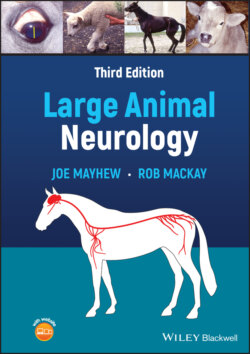Читать книгу Large Animal Neurology - Joe Mayhew - Страница 26
Gait and posture
ОглавлениеThe evaluation of posture and gait comprises the following minimal components:
Observing the patient walking in a straight line viewed from the side as well as from behind and in front.
Firmly but not abruptly pulling laterally on the tail with the patient standing still and while the patient is being walked forward.
Assessing stride length and trajectory and placement of all four limbs both while walking freely and while the tail is pulled to each side in turn.
Trotting the patient away from and back toward the examiner.
Watching the patient being walked in circles and turning very tightly in circles in both directions.
Taking the patient oneself and, by walking backward, leading the patient forward in a serpentine path to observe limb placement. In this maneuver, one leads in a manner such that the direction of each forefoot in turn is required to change direction during its swing phases.
Leading the patient oneself to walk in circles and to turn tightly in circles in both directions.
Continuing these maneuvers while pulling on the lead rope and the tail simultaneously, assessing limb placement and strength of resistance.
Releasing the tail abruptly after stopping from turning tightly to observe for adoption of and standing with abnormal limb positions.
Hopping the patient on at least the thoracic limbs (Figure 2.4).
Manually placing the limbs in abnormal positions and placing them with the dorsum of the hoof resting on the ground are not useful in detecting neurologic motor or proprioceptive abnormalities in our hands. Likewise, the use of a sliding sack under one weight‐bearing foot in turn never alone appears to add information regarding the assessment of conscious proprioception.
A patient that is or can be placed in lateral recumbency can be tested for classical limb reflexes. In practical terms, these simply consist of the flexor reflexes in thoracic and pelvic limbs and the extensor or patellar reflex in the pelvic limbs; other described reflexes (responses) are very unrepeatable and unreliable in adult patients while trying to define an anatomic neurologic lesion site. A reflex is reported as present or hyperactive in a limb if such a normal or very strong response is detected in the recumbent patient while the limb is uppermost or is dependent. A clonic response is when there are multiple muscle contractions occurring in response to a single stimulus. A crossed extensor reflex occurs when there is limb extension into the untested limb in response to a graded, increasing stimulus to a distal limb. Hyperactive, clonic, and crossed extensor reflexes all reflect central motor pathway lesions with sparing of the final motor pathway.
Figure 2.4 Performing postural reactions such as hopping on one thoracic limb as shown can express underlying neurologic deficits. These include a slow onset of response on a limb with flexor weakness, a hypermetric response with spinocerebellar disease, and collapsing on a limb with extensor weakness. In larger patients where these testing procedures are difficult or impossible, such observations may depend on performing complex gait maneuvers such as turning tightly on a slope and walking the patient in a serpentine path and changing direction while one forelimb is protracting in its stride.
All other limb reflex testing in adult patients really does not usefully contribute to a neuroanatomic diagnosis and results of such additional limb reflex testing should not be used to alter a neuroanatomic diagnosis achieved by the interpretation of results of the remainder of the examination. Finally, poor or absent reflexes can be found in a heavy patient very soon after the onset of recumbency, presumably due to mechanical and decubital effects.
At the conclusion of the gait evaluation, any issue that is unclear can be returned to for further evaluation and confirmation, and further testing can be considered as appropriate. As suggested above, this will frequently include observations while blindfolded, hemiwalking, hopping on pelvic limbs, wheel barrowing on thoracic limbs with head and neck held extended, after exercise, up and down slopes, and when performing any expected tasks.
For documentation, further study, and possible consultation purposes, taking a video of any possible neurologic signs displayed by a patient is worth considering. It must be recalled however that a badly produced video clip is likely to be worse than a clear verbal or written description—the description, not its interpretation. At best, video sequences of neurologic movement abnormalities, particularly involving the gait, are less precise and less accurate than in real life.
